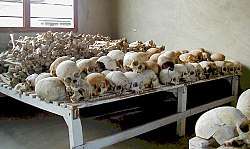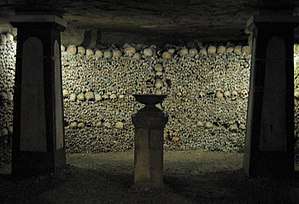Dark tourism
Dark tourism (also Thana tourism, black tourism, morbid tourism or grief tourism) has been defined as tourism involving travel to places historically associated with death and tragedy.[1] More recently, it was suggested that the concept should also include reasons tourists visit that site, since the site's attributes alone may not make a visitor a "dark tourist".[2] The main attraction to dark locations is their historical value rather than their associations with death and suffering.[2][3] Holocaust tourism contains aspects of both dark tourism and heritage tourism.


Field of study
While there is a long tradition of people visiting recent and ancient settings of death, such as travel to gladiator games in the Roman colosseum, attending public executions by decapitation, and visiting the catacombs, this practice has been studied academically only relatively recently. Travel writers were the first to describe their tourism to deadly places. P. J. O'Rourke called his travel to Warsaw, Managua, and Belfast in 1988 'holidays in hell',[4] or Chris Rojek talking about 'black-spot' tourism in 1993[5] or the 'milking the macabre'.[6]
Academic attention to the subject originated in Glasgow, Scotland: The term 'dark tourism' was coined in 1996 by Lennon and Foley, two faculty members of the Department of Hospitality, Tourism & Leisure Management at Glasgow Caledonian University,[1] and the term 'thanatourism' was first mentioned by A. V. Seaton in 1996, then Professor of Tourism Marketing at the University of Strathclyde.[7]
As of 2014, there have been many studies on definitions, labels, and subcategorizations, such as Holocaust tourism and slavery-heritage tourism, and the term continues to be molded outside academia by authors of travel literature.[8] There is very little empirical research on the perspective of the dark tourist.[2] Dark tourism has been formally studied from three main perspectives by a variety of different disciplines:
Hospitality and tourism
Scholars in this interdisciplinary field have examined many different aspects. Lennon and Foley expanded their original idea [1] in their first book, deploring that "tact and taste do not prevail over economic considerations” and that the "blame for transgressions cannot lie solely on the shoulders of the proprietors, but also upon those of the tourists, for without their demand there would be no need to supply."[9]
Criticism
The exploitation of the deceased
Whether a tourist attraction is educational or exploitative is defined by both its operators and its visitors.[10] Tourism operators motivated by greed can "milk the macabre"[6] or reexamine tragedies for a learning experience. Tourists consuming dark tourism products may desecrate a place and case studies are needed to probe who gains and loses.[11]
Misinformation
Chris Hedges described the "Alcatraz narrative as presented by the National Park Service" as "whitewashing", because it "...ignores the savagery and injustice of America's system of mass incarceration". By omitting challenging details, the park service furthers a "Disneyfication", per Hedges.[12]
Example destinations
Destinations of dark tourism include castles and battlefields such as Culloden in Scotland and Bran Castle and Poienari Castle in Romania; former prisons such as Beaumaris Prison in Anglesey, Wales and the Jack the Ripper exhibition in the London Dungeon; sites of natural disasters or man made disasters, such as Hiroshima Peace Memorial Park in Japan,[13] Chernobyl in Ukraine[14][15][16] and the commercial activity at Ground Zero in New York one year after September 11, 2001.[17] It also includes sites of human atrocities and genocide, such as the Auschwitz concentration camp in Poland,[18] the Nanjing Massacre Memorial Hall in China, the Tuol Sleng Genocide Museum in Cambodia; the sites of the Jeju Uprising in South Korea[10] and the Spirit Lake Internment Camp Centre near La Ferme, Quebec as an example of Canada's internment operations of 1914–1920.[19]
In Bali "death and funeral rites have become commodified for tourism ..., where enterprising businesses begin arranging tourist vans and sell tickets as soon as they hear someone is dying."[20] In the US, visitors can tour the Holocaust Memorial Museum in Washington D.C. "with an identity card which matches their age and gender with that of a name and photo of a real holocaust victim. Against a backdrop of video interpretation portraying killing squads in action, the pseudo holocaust victim enters a personal ID into monitors as they wander around the attraction to discover how their real-life counterpart is faring."[21] In Colombia, places associated with Pablo Escobar, the drug lord from the Medellín Cartel, became hotspots for dark tourism through Escobar-themed tours. In Medellín, visitors frequent Roberto Escobar's private museum of his infamous brother, the house where he was killed, and La Catedral, Escobar's prison. Another famous place is the Haciénda Nápoles estate located between Bogotá and Medellín, near Puerto Triunfo. [22]
See also
- Dark Tourist (television series)
- Disaster tourism
- Slum tourism
- War tourism
Notes
- Foley, Malcolm; J. John Lennon (1996). "JFK and dark tourism: A fascination with assassination". International Journal of Heritage Studies. 2 (4): 198–211. doi:10.1080/13527259608722175.
- Rami Khalil Isaac; Erdinç Çakmak (2013). "Understanding visitor's motivation at sites of death and disaster: the case of former transit camp Westerbork, the Netherlands". Current Issues in Tourism. 17 (2): 1–16. doi:10.1080/13683500.2013.776021.
- Courtney C. Reed (April 2007). "Shedding Light on Dark Tourism". gonomad.com. Retrieved 1 March 2014.
- O'Rourke, P. J. (1989). Holidays in Hell. London: Picador. ISBN 978-0330306836.
- Rojek, Chris (1993). Ways of Escape: Modern Transformations in Leisure and Travel. London: Palgrave Macmillan. ISBN 978-0333475782. Retrieved 1 March 2014.
(P 142)The leisure forms constructed around black spots certainly give signs of repetition-compulsion and seeking the duplication of experience. (p170) The gravity and solemnity of Black Spots have been reduced by moves to make them more colorful and more spectacular than other sights on the tourist trail. For example, in 1987 the government of Thailand unveiled plans to restore the famous Death Railway …
- Dann, G (1994). "Tourism the nostalgia industry of the future". In W. Theobald (ed.). Global Tourism: The Next Decade. Oxford: Butterworth Heinemann. pp. 55–67.
- Seaton, AV (1996). Guided by the dark: from thanatopsis to thanatourism. Int Journal of Heritage Studies. 2. pp. 234–244. doi:10.1080/13527259608722178. ISBN 9781136394966. Retrieved 1 March 2014.
- Jonathan Skinner, ed. (March 15, 2012). Writings On The Dark Side Of Travel. Berghahn Books. ISBN 978-0857453419.
- Lennon, J.; Foley, M. (2000). Dark tourism: The attraction of death and disasters. London: Thomson Learning.
- Darryl Coote (2010-06-12). "Exploitation or healthy interest? An analysis of dark tourism". Jeju Weekly. Retrieved 28 February 2014.
- Richard W. Butler; Douglas G., eds. (1999). Contemporary issues in tourist development. Routledge. p. 122. ISBN 978-1134623600.
- Chris Hedges (30 November 2014). "Alcatraz: A Prison as Disneyland". Truthdig.com. Zuade Kaufman. Retrieved 5 December 2014.
- "Hiroshima Peace Memorial Museum website". Hiroshima Peace Memorial Museum. 2011. Retrieved 1 March 2014.
- "Chernobylzone". chernobylpripyat.com. Archived from the original on February 25, 2015. Retrieved February 25, 2015.
- "Chernobyl Tours". Ukrainianweb.com. Retrieved February 28, 2014.
- "Chernobyl tour, official provider of Chernobyl exclusion zone". Chernobyl-TOUR. Retrieved 28 February 2014.
- Jayson Blair (June 29, 2002). "Tragedy turns to tourism at Ground Zero". 2002 The Age Company Ltd. Retrieved March 1, 2014.
- "Memorial Museum Auschwitz Birkenau". Państwowe Muzeum Auschwitz-Birkenau w Oświęcimiu. Retrieved February 28, 2014.
- "Launch of Quebec Internment Spirit Lake Interpretive Centre". press release. Canadian First World War Internment Recognition Fund. July 2010. Retrieved February 28, 2014.
- McLaren, Deborah (June 2003). Rethinking Tourism and Ecotravel (2 ed.). Kumarian Press. p. 48. ISBN 978-1565491694. Retrieved 1 March 2014.
One of the most disturbing phenomena in Bali is the commercialization of cremation ceremonies.
- Stone, P (2005). "Dark Tourism Consumption – A call for research". E-Review of Tourism Research. 2 (5): 109–117.
contemporary society with its ...late capitalism broad defining features include an increased commercial ethic and commodification; a de-differentiation of time and space through global technological communication; and an introduction of anxiety and doubt over the project of modernity.
- Pablo Escobar and Colombian Narcoculture, by Aldona Bialowas Pobutsky (UF Press 2020), p.40-45
External links
- "What is dark tourism?", The Guardian special feature
- Chernobyl: Unlikely Tourist Spot - slideshow by Life magazine